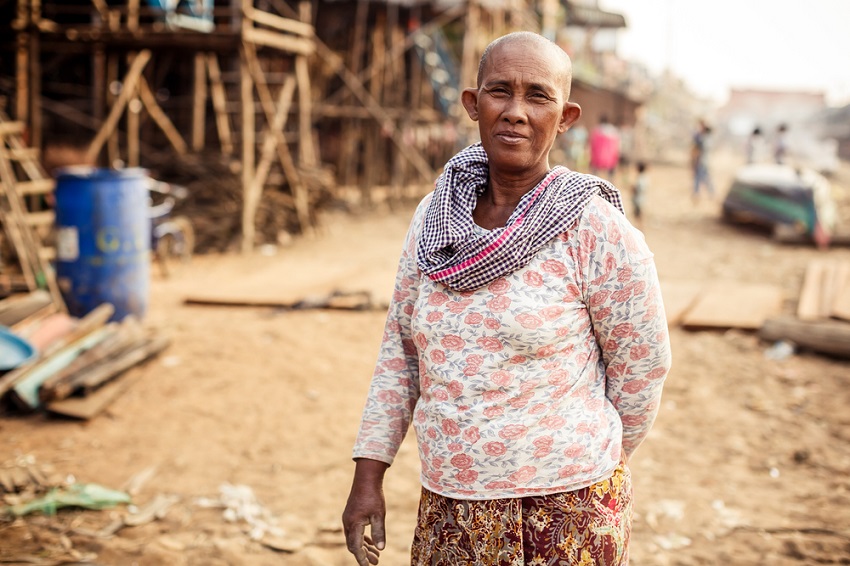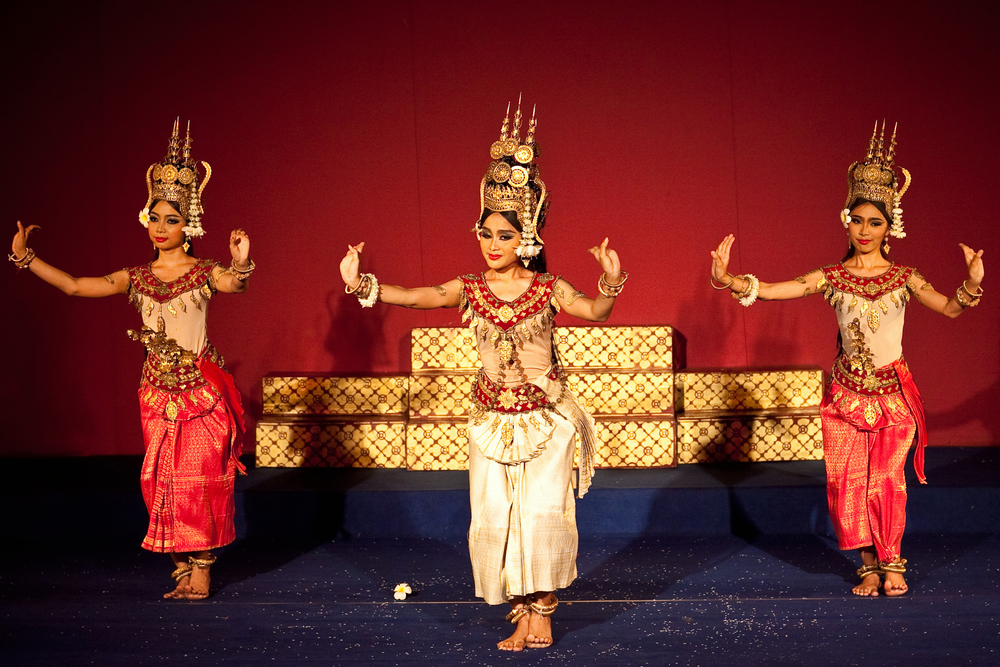Cambodia - ethnicity
From the information in 2013, Cambodia has an overall population of 15.57 million (THE WORLD BANK, 2016) which can be divided into 4 ethnic groups: Khmer (90%), Vietnamese (5%), Chinese (1%), and Cham. (Jesudas M.Athyal,Editor, 2015:29) Others are 19 minority groups which are divided into two groups according to their language families.
1. Austro-Thai orMalayan-Polynesians includes Jorai andRhade (Frederic Bourdier, 2009)
2.Mon-Khmer includesKachac, Tampuon, Brao, Kreung, Kravet, Lun, Phnong,Stieng, Kraol , Mel ,Chong , Samre , Pear , Saoch, Souy , Khmer Khe , Kuy (Frederic Bourdier, 2009)
From the proportion of the population, it is clear that Khmer is the main ethnic of Cambodia. The Khmers were the oldest ethnic group that had stepped in the place of Mon. They also established Khmer Empire, the form of governance, culture, and economy. From Khmers’ point of view, they see themselves as one ethnic group that is composed of 3 sub ethnic groups according to the root of their race and language.
1. Khmer in Cambodia that speaks Cambodian (Frederic P. Miller,Agnes F. Vandome, John McBrewster(Ed.), 2009, p.1)
2. Surin Khmer living in Cambodia region, which later on has become a part of Thailand This sub ethnic group can use both their own dialect and Thai; however, they still keep close relationship with Khmers in Cambodia. Some of them stay in Cambodia because of marriage. (Frederic P. Miller,Agnes F. Vandome, John McBrewster(Ed.), 2009, p.1)
3. Khmer Krom living in Vietnam region that used to be a part of Cambodia They can speak both Cambodian and Vietnamese. A lot of South Cambodians escaped to Cambodia after the invasion of Vietnamese communists. (Frederic P. Miller,Agnes F. Vandome, John McBrewster(Ed.), 2009, p.1)
Vietnamese is the second largest ethnic group in Cambodia. According to reports from Indochina Studies Center Burapha University, Vietnamese might migrate to Cambodia since 1917. More Vietnamese escaped to Cambodiawhen there were political issues in Vietman living on handcraft, hotel, and other businesses (Indochina Studies Center Burapha University, p.86)
Another report showed that Vietnamese was the largest minorities in Cambodia. In 1998, Vietnamese population was 4.3 % of the population of Cambodia. This might happen because both countries share the same border. However, since 1917, whenever Vietnam had a crisis or rumors that could bring wealth in Cambodia spread out, the Vietnamese would move to Cambodia seeking for refuges and wealth. Therefore, Vietnamese population has increased in Cambodia. Most of them lived together to preserve their culture in Phnom Penh, Kandal, and Kampong Cham (Khien Theeravit, 2000, p.56).
Chinese is the third largest ethnic groups in Cambodia. This ethnic group had a good relationship with Khmer because they shared the same religion, Buddhism. Also, intermarriage between both ethnic groups brought them together. This might be the result of the policy enforced by the government under King Norodom Sihanouk that reserved agriculture only for Khmer in 1956-1957. Most Chinese changed their nationality to Khmer and their children automatically became Khmer (Indochina Studies Center Burapha University, p.87) However, after the coup of General Lon Nol, some Chinese closed their Chinese school and newspaper businesses. Later, in the age of Khmer Rouge (Red Khmer) which was the crucial time of change for Cambodia, Chinese language and Chinese culture were prohibited.
In 1979-1989, Vietnam took over Cambodia. Most Chinese evacuated from Cambodia and came back after the Paris Peace Agreements. Chinese took this opportunity to improve their economic status. Chinese publications and schools were back to business after 20 years of prohibition (KhienTheeravit, 2000, p.56).
The fourth largest ethnic group in Cambodia is Cham. Most of Chams are Muslims who live in the area around Tonle Sap Lake located in the west, south, and central of the Mekong River. From an article “Minority, Cham, and the Role of Nation building in Cambodia”, it showed that Cham descended from travelers who settled in Southeast Asia approximately 2,200 years ago and built Champa Kingdom that used to rule over the center and southern parts of Vietnam in the present day. Wars between Champa and its neighbor countries such as China and Dai Viet in 4-5th centuries cost the kingdom to be left with only the territory around central and southernplains near Mekong River which were in Laos, Cambodia, and Thailand in the present day. From the last evacuation in 1835, Cham in Cambodia merged with Cambodian without any problem with other ethnic groups that mostly were Buddhists (Plubplueng Kongchana & others, 2005)
When Cambodia was governed by the government, the life of Cham faced a big change. For example, in 1970-1975, governed by General Lon Nol, many Cham were in high political and military positions. They took this chance to establish a liberation front to release Champa from Vietnam. However, when they were ruled by Red Khmer in 1975-1979, the crucial time that caused a significant tragedy in Cambodia, Cham language was prohibited along with their religion, Islam. They were forced to raise pigs and consume them. Mosques, Islamic schools, and copies of the Qur'an were destroyed. As a result, many Cham escaped to neighbor countries such as Thailand and Malaysia. In 1979-1989, Red Khmer lost its power. One of Cham became a Ministry of Agriculture. Later in 1989-1991, Chams in Cambodia rebuilt their community. Mosques and Islamic schools were reconstructed. Other Arabiancommunities also donated copies of the Qur'an and money supporting Chams to attend the Hajj ceremony (Plubplueng Kongchana & others, 2005).
Since 1991, Chams received agood education, public health, economy, relation with other countries, and religious support. Many Muslims got into high positions in the government. According to the policy of Prime Minister Hun Sen, Cambodia became a country with the multicultural society in order to restore and develop the country. Mosqueswere returned to Muslims. The Halal Institute was established. Muslims were allowed to wear religious clothing in both public and private schools. Muslim prayer rooms were prepared in Phnom Penh and Siem Reap airports. Other Islam missionary activities were also supported (Plubplueng Kongchana & others, 2005).
However, two years later, Cham faced a big crisis in 2014. There was a conflict between Chams and Pnong (Bunong) in Mondulkiri located in the east of Cambodia close to Vietnam border. The conflict was caused by a rubber-plantation project and a land management in the forest area that originally belonged to Pnongs. These projects were planed in order to solve the poverty problem for Muslims. Finally, Pnongs, the locals came to a conflict with Chams, the newcomers. Till today, this problem along with a statelessness issue of some Pnongs and Chams are still unsolved by the government (Transborder News, 2014).
Nevertheless, we did not hear much about conflicts between ethnic groups in Cambodia. The reason might be that the main ethnic group was Khmers who have lived here for many generations. It might also be that many ethnic groups traveled off country living their lives as labors in other countries. However, the conflict between Chams and Pnongs made us wonder whether there were other ethnic groups facing the same problem and waiting for help from the government.
Bibliography
Theeravit, K.(2000). Cambodia History, Social, Economy, Security, Politic and Foreign Affairs, pp.56.
The Conflict Between Ethnic Groups in Cambodia Reached Its Peak Since the Rubber -Plantation Policy Was Used. (2014). Retrieved from http://transbordernews.in.th/home/?p=537
Kongchana, P. & Others.(2005). Chams, the Minority and Their Roles in Building Cambodia. Retrieved from http://rescom.trf.or.th/display/keydefault.aspx?id_colum=3276
Indochina Studies Center Burapha University.(n.d.)Fundamental Information of Cambodia.





